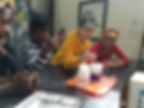
Middle School
Ages 12 to 14 Years Old
Middle school ushers in a new level of independence, which must be provided for in the Montessori environment by increasing activity from the point of view of work level, choices, and planning. In the middle school, the Great Lessons, timelines, and charts are replaced with overviews of general sequences of learning for which the student becomes responsible in the context of an integrated whole. Within this overview, the student has open time to collaborate on both self-initiated and instructor-initiated projects.
Open time allows for individualized instruction, a natural pace for absorption of material presented for both mastery and emotional understanding, unlimited depth of pursuit based on student interest, and release time to study art, science, music, business, and other topics students choose.
The general premise for the adolescent program is that it must bring into consciousness the moral and world view of the elementary years. Philosophical ideas related to natural history and cultural history now come into play. Great Lessons evolve into great ideas derived from a serious approach to the humanities. For example, "life, liberty, and the pursuit of happiness" may be tied to a specific part of American history, but this ideal also has a life in the history of philosophy and literature.
Consistent with the moral relationships stressed in the elementary program, the adolescent can make great cognitive leaps while integrating ideas and values in conjunction with current events, home life, or community activities.
Service programs such as working in a soup kitchen, farming as a community venture, and apprenticeships or mentorships in the workplace are part of an advancing "going out" that gives the adolescent a combined vocational and liberal arts curriculum with a particular emphasis on economic enterprise.
Adolescent programs characteristically have discrete spaces for specialized activities: photo lab, science lab, stage, art room, and lesson rooms all adjacent to open space that unifies the siderooms.
The following curriculum areas are offered in the Montessori middle school:
Social sciences, science, and geography: The student integrates history utilizing themes from earlier studies in natural and cultural history, including interdependency, evolution, life cycles, matter and energy, behavior and culture, mental health, physical health, agriculture, government, manufacturing, communication, world systems, earth preservation, and so on, in the context of social responsibility and governance. Primary readings from each historical period are emphasized.
Language arts: The student develops confidence in self-expression utilizing the seminar, oral presentation, debates, drama, video, photography, essays, play-writing, poetry, and short stories; explores related accounts of historical and philosophical material through literature utilizing components of style, genre, characterization, interpretation, and the art of discussion.
Second language and grammar: The student revisits grammar through the study of a second language and reviews complex sentences and paragraph structure in English.
Mathematics: The student uses higher-order thinking skills to solve problems in relation to a variety of challenges, from practical money transactions to algebraic relationships; explores in-depth numbers, properties, simple equations, higher measurement, computer calculation and graphics, geometric proofs, and algebraic equations.
Practical management: The student manages reality-based operations in economic enterprises including agriculture, fund-raisers, travel, volunteerism and service, apprenticeship, and computer programming.
Fine arts: The student utilizes a discipline-based arts education plan which presents individual artistic areas of painting, acting, singing, composing, photography, dance, and sculpture, and includes a general education for aesthetic literacy which integrates the arts with other academic endeavors.
Farming: The student engages in elements of farming as an economic enterprise through the care of plants and animals, the maintenance of simple machines, the understanding of land use, and the operations of accounting, sales, personnel records, and working relations in ongoing projects.
The Elf Owl Cafe
The Middle School micro economy is a small business which helps the Middle School students learn different jobs and responsibilities in a business. From doing jobs, the students learn different skills like leadership, organization, responsibility, participation, cooperation, time management, and teamwork. It also allows the students to obtain more knowledge about the economy by working in a small business. Many of the skills the students are learning and building are helping them to become better people and preparing them for what is to come later on in life. Almost all Montessori middle schools have a micro economy.
Our micro economy is a cafe which we named the Elf Owl Cafe. At the beginning of the year all the students have a job interview for the position they want to have in the business. The interview gives the students a good idea of what a real interview will be like in their future. After the interview, each student is assigned their job. The jobs we have in our cafe are Logistics Manager, House Manager, Finance Manager, Advertising/Marketing Manager, Kitchen Manager, and Manager Liaison. From doing the jobs the students learn different skills. For example, the Finance Manager learns how to manage money and run a bank account and the Kitchen Managers learns how to schedule cooks, order supplies, and make sure orders leave the kitchen correctly . A micro economy has the focus of helping the students experience a realistic business along with the benefits of learning new skills that can be used in the future.











